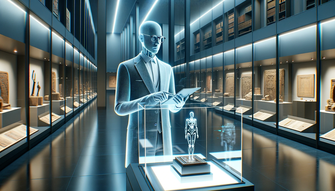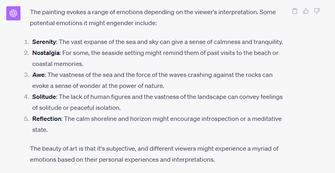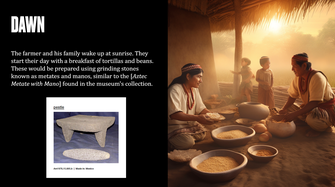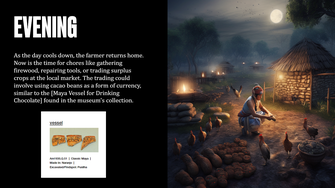How museums could be using AI
AI can be a powerful tool for museums, both for curation and to bring objects to life. We wanted to share our ideas for how museums can use this new technology to delight visitors and enhance their experience.
AI is unlocking exciting new possibilities for a whole range of industries and museums are no exception.
An eternal challenge that museums face is how to present their collections in an engaging way to a diverse range of audiences and communities. How can these collections then be updated to keep in line with emerging ways of being dynamic and staying relevant?
A lot of our work with the world’s leading museums has been to apply the latest technologies to their websites and digital collections so that they can tell dynamic, relevant and contemporary stories, using their collections objects as a base. For example, we helped the Science Museum offer a digital curation to coincide with COP 26. This is easier than creating a whole new physical gallery, but it still demands heavy investment in curator time and digital specialists to research and create the content.
At Numiko, we’ve been fascinated with breaking down the separation between a museum’s physical presence and its digital assets for a while and asking ourselves questions like:
- What if we could curate a 1:1 experience for every single visitor based on their interests, age, or length of time they have to visit?
- What if we could rapidly assemble a tour through a museum that showcased a series of objects telling a hyper-topical story pertinent to the current news agenda?
- What if the personalisation offered on digital platform could provide an interpretive layer to a visitor’s physical experience?
The challenge is how a museum team could generate the almost infinite amount of content creation these applications would need. The arrival of generative AI and specifically, large language models (LLMs) such as OpenAI’s Chat-GPT, means we can instantly generate unique content based on a corpus of knowledge (such as a collection management system).
Now, there are challenges and cautions that come with these technologies, such as their accuracy, bias, data provenance and ‘traceability’, but these are challenges that exist for any application of this technology and will be solved.
We’ve been thinking about some blue-sky concepts that we think will help our team and the sector explore the possibilities and challenges generative AI presents.
The ‘always-on’ museum guide
Imagine an AI agent that has been trained on a museum’s digitised collection. They could answer any question about a specific object, or the collection as a whole. They could become an ‘always on’ museum curator, guide, and interpretation expert that is accessible by anyone, at any time. This could be a user visiting a museum’s digital collection online from the other side of the world, or in person, via a real-time personalised audio tour on a smartphone.
We created a very quick proof of concept, using Chat-GPT to generate a list of objects in the Science Museum that told the story of the birth of modern computing. We asked Chat-GPT to work this into a narrative using some creative prompt engineering and rendered that as audio using an AI text-to-speech service in near real time.
You can imagine this as an application that asks a visitor a few questions about their interests, how long they have to spend at the museum, and then almost instantly delivers a hyper-personalised audio tour directly to their smartphone. A visitor could even interact with the AI curator, asking questions about objects as they progress through the tour.

Taking on historical personas
A large language model can be trained on interviews, books or transcripts, enabling it to respond in the style of a specific person. It’s even possible to create books that you can converse with because the AI model has absorbed the book’s content and the perspective of the author.
For example, Tyler Cowen published a ‘generative book’ called Who is the Greatest Economist of all Time and Why Does it Matter? Users can converse with the book’s content by asking specific questions.
A similar approach could be taken to bringing historical figures to life. These could be trained on books about them or even their own writing. Imagine being in the Science Museum and being able to talk to Ada Lovelace about writing the world’s first computer programme. Or in the Natural History Museum being able to chat with Charles Darwin about evolution.
The AI could also be used to create ‘synthetic characters’, which are based on material from the collection. For example, the Museum of London has been collecting the life stories of Londoners since the 1980s. Their archive contains nearly 5,000 hours of recorded interviews with a wide variety of people, covering topics from Windrush and refugees, to taxi drivers’ tales and 1950s teenage wisdom.
A model could be trained on this content, allowing users to interact with it a completely natural way, simply by verbally asking questions and getting an answer in an AI-generated voice. Imagine if an 11-year-old was working on their history homework on the Blitz and could speak to an 11-year-old from East London in 1940 about their experience. Some museums are already experimenting with this technology. For example, the Shoah Foundation used natural language processing that allows students and educators to ask questions that prompt relevant responses from videos of Holocaust survivors, bringing their stories to life for a new generation.
Exploring collections in new ways
While online collection management systems provide many ways to search and filter objects from a collection, they can be limiting. Objects are often curated in a way that relies on internal taxonomies, metadata and cataloguing details, rather than considering an explorative, serendipitous experience for visitors.
‘Objects and collections can be meaningful to a person, group, or community in ways that can be overlooked by curators working alone. We need new and critical public reinterpretations of collections and to think imaginatively about how to broaden the range of people to whom collections can be meaningful.’
Museum’s Association - Recommendations: Relevant Collections
Crowd sourcing platforms, such as ArtUK’s Participate Tagger, set out to consider different ways to curate collections but they rely on the goodwill of the community, which tends to wane over time.
With Chat GPT’s newly released image recognition, images can be analysed instantly, providing tags of what visual elements the algorithm can identify.
This holds great potential for enriching the metadata in collections, allowing the objects to be curated in more creative and user-specific ways. For example, we can start to delve into what emotions may be evoked by a specific painting and could provide ‘micro collections’ based on a visitor’s mood.
Whilst this may seem slightly gimmicky at first glance, it could open up interesting interfaces for projects such as the House of Memories, and other projects for people living with dementia and art therapy more generally.
This unconventional linking of objects wasn't practical before, it would take too much time to identify visual attributes, let alone anything more thematic or conceptual. These new AI platforms commodify this capability and can work at huge scale, analysing an entire national collection in days.

Adding context
A museum's role isn't just to be a custodian of objects, it is to bring them to life and help visitors imagine what it was like to be in a different time and place. The fascination with a sword from the Royal Armouries isn’t just about appreciating the intricate detail and craftsmanship. These objects provide a physical connection to another world. Who held that sword on that day? What did they see? How did they feel?
We decided to play with this as a creative proof of concept. We took a series of objects from the British Museum’s online Mesoamerican collection. Using the generative image creation platform Midjourney, we were able to create illustrative images of the objects as they may have been used by their original owners.
We got carried away and created a whole series of images of what a day in the life of a Mesoamerican farmer may have looked like. We produced these in under an hour. It just wouldn’t be economically possible for a museum to commission an interpretive artist to produce illustrations for anything but a small selection of the collection. This technology means it could be now rolled out across every object.




Final thoughts
The rapid progress in AI tools means museums are excited to explore new ways to engage their visitors. We believe they offer the sector one of the most powerful tools for engaging audiences since the arrival of the internet. It’s important to remember AI is not without issue, be it technically, ethically or environmentally. But enabling your institution to experiment, test and learn in a safe, supportive and exploratory environment is vital to success.
If you’d like to get started with using AI for your museum’s collections or website, get in touch via [email protected] and let’s start exploring the possibilities.

We're building AI tools into Drupal to make it a more powerful CMS. Our prototype helps streamline CMS admin tasks.